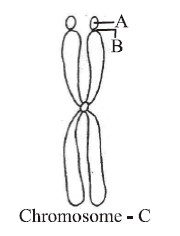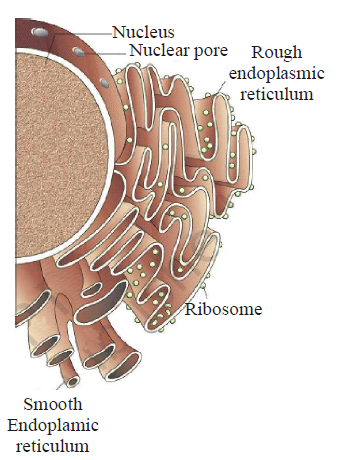Most of water, in mature plant cells occurs in
nucleus
cell wall
vacuoles
cytoplasm
Correct Answer :
C. vacuoles
In plant cells, the vacuoles can occupy upto 90 percent of the volume of the cell. The vacuole is bound by a single membrane called tonoplast.
Related Questions
According to widely accepted fluid mosaic model cell membranes are semi-fluid, where lipids and integral proteins can diffuse randomly. In recent years, this model has been modified in several respects. In this regard, which of the following statements is incorrect?
Proteins in cell membranes can travel within the lipid bilayer.
Proteins can also undergo flip-flop movements in the lipid bilayer.
Proteins can remain confined within certain domains of the membrane.
Many proteins remain completely embedded within the lipid bilayer.
Membranous extensions in blue green algae are known as
phytochrome
chromatophore
mesosome
pneumatophore
Which one of the following is not considered as part of the endomembrane system?
Golgi complex
Peroxisome
Vacuole
Lysosome
The cytoskeleton is a proteinaceous network of fibres in the cytoplasm. It is involved in
mechanical support.
motility.
maintenace of cell-shape.
all of the above
Which of these is wrongly matched?
Chloroplasts Chlorophyll
Elaioplasts Starch
Chromoplasts Carotenoids
Amyloplasts Carbohydrates
Which of the following statements are correct ?
- In prokaryotic cells, a special membranous structure formed by the extension of the plasma membrane into the cell is known as polysome.
- The smooth endoplasmic reticulum is the major site for synthesis of glycoproteins.
- RuBisCO is the most abundant protein in the whole biosphere.
- Mitochondria, chloroplasts and peroxisomes are not considered as part of endomembrane system. Of the above statements
(iii) and (iv)
(i) and (ii)
(ii) and (iii)
(i) and (iv)
Which of the following lacks cell wall?
Gametes
Amoeba
Mycoplasma
All of these
pH of vacuolar cell sap is
neutral and isotonic.
alkaline and isotonic.
acidic and hypertonic.
equal to cytoplasm and isotonic.
Which of the following is absent in prokaryotes?
DNA
RNA
Plasma membrane
Mitochondria
Golgi apparatus is absent in
higher plants
yeast
bacteria and blue-green algae
None of the above
The best way to identify a cell as either prokaryotic or eukaryotic is to determine whether
it came from a single-celled or multicellular organism.
it has a nucleus.
it has a plasma membrane.
it has cytosol.
Satellite means
terminal part of the chromosome beyond secondary constriction.
terminal part of the chromosome beyond primary constriction.
terminal part of chromosome beyond tertiary constriction.
none of the above
Which one of the following combination is mismatched?
Glycocalyx May be capsule or slime layer
Pili Reproduction
Cell wall Protective, determines shape, prevents from bursting
Flagella, pili and fimbriae Surface structures of bacterial cell
The given figures show two types of cell. Which structures are common to both the cells?

Nucleus and cell wall
Nucleus and cytoplasm
Ribosomes and flagella
Ribosomes and cell wall
The cell theory was given in year 1839 by Schleiden and Schwann. According to this theory all organisms are composed of cell and cells are the basic unit of life.
How did this theory help in the field of science?
It helped to study the working of cells.
It helped in curing diseases caused by cell.
It helped in restating the earlier theories on cell.
It helped in introducing the use of microscopes to study cell.
Select the correct match of the types of neuron present in column I with its location given in column II.
| Column I | Column II |
|---|---|
| A. Centrioles | (i) Non-membrane bound organelle which helps in cell division |
| B. Fimbriae | (ii) Special structure of bacteria which help them to attach with rocks in stream and also to host tissue |
| C. Endomembrane | (iii) Includes those organelles system whose functions are coordinated |
| D. Mitochondria | (iv) Divide by fission and site of aerobic respiration |
A - (i), B - (ii), C - (iii), D - (iv)
A - (iii), B - (i), C - (ii), D - (iv)
A - (iii), B - (i), C - (iv), D - (ii)
A - (i), B - (iv), C - (iii), D - (ii)
The following diagram represents a structure chromosome.
Identify the structures marked as A, B and C.

A - Satellite, B - Primary constriction, C - Acrocentric
A - Satellite, B - Secondary constriction, C - Metacentric
A - Satellite, B - Centromere, C - Telocentric
A - Satellite, B - Centromere, C - Submetacentric
Grana are
protein storing plastids.
coloured plastids.
stacks of thylakoids.
individual thylakoids present in stroma.
Nucleolus is
rounded structure found in cytoplasm near nucleus.
rounded structure inside nucleus and having rRNA.
rod-shaped structure in cytoplasm near the nucleus.
none of the above.
A student placed two cells in the same solution in two different containers. The observation was given in the table.
| Container | Observation |
|---|---|
| 1 | Cell burst |
| 2 | Cell does not change its shape |
Which structure maintains the shape of the cell present in container 2 and provides the most significant difference between the two cells?
Nucleus
Cell wall
Chloroplast
Cell membrane
Which one of the following organelle given below is correctly matched with its function ?

Golgi apparatus Protein synthesis
Golgi apparatus Formation of glycolipids
Rough endoplasmic reticulum Protein synthesis
Rough endoplasmic reticulum Formation of glycoproteins
Microtubules are absent in
mitochondria
centriole
flagella
spindle fibres
Which of the following statement is false?
The ribosomes of a polysome translate the mRNA into protein.
Mitochondria divide by fragmentation.
All cell arise from pre-existing cells.
The lipid component of the membrane mainly consists of phosphoglycerides.
Select the statements which are related to Schwann.
- He reported that cells have a thin outer layer which is today known as plasma membrane
- Cell wall is a unique character of the plant cell.
- Body of plants and animals are composed of cells and products of cells.
Only (i)
Only (iii)
(i) and (iii)
All of these
Centrifugation of a cell results in the rupture of the cell membrane and the contents compacting into a pellets in the bottom of the centrifuge tube. Bathing this pellet with a glucose solution yields metabolic activity including the production of ATP. One of the contents of this pellet is most likely which of the following?
Cytosol
Mitochondria
Lysosomes
Golgi bodies
In prokaryotes, chromatophores are
specialized granules responsible for colouration of cells
structures responsible for organizing the shape of the organism.
inclusion bodies lying free inside the cells for carrying out various metabolic activities.
internal membrane system which becomes extensive and complex in photosynthetic bacteria.
Chromosomes having equal or almost equal arms are called
metacentric
acrocentric
polycentric
acentric.
8.A student was given cell samples (A and B) to identify parts which are highlighted. He observed the samples under the microscope and list down the function of the part of cell sample. The information collected by the student is listed in the table below, on the basis of which the student infers that the samples contain the organelles.
| Sample A | Sample B |
|---|---|
| Make energy available for cellular metabolism | Generates ATP and synthes izes s ugar |
| Absent in cell that carry oxygen throughout the body | Present in plant cell |
| Called the energy currency of cell | Source o f all the food energy |
Identify the part highlighted in the sample A and B and explain why they were called as semi-autonomous organelles?
Sample A - Mitochondria, Sample B - Chloroplast; because both the organelles are double membrane bound structure.
Sample A- Mitochondria, Sample B - Chloroplast; because they both are capable of synthesis of their own proteins only.
Sample A - Mitochondria, Sample B - Chloroplast; because they are capable of synthesis of their own proteins and contain their own DNA.
Sample A- Mitochondria, Sample B - Chloroplast; because they contain their own DNA to transfer the genetic information from one generation to another.
Which one of the following cellular parts is correctly matched with their characters ?
Centrioles Sites for active RNA synthesis.
Lysosomes Optimally active at a pH of about 8.5.
Thylakoids Flattened membranous sacs forming the grana of chloroplasts.
Ribosomes Those on chloroplasts are larger (80S) while those in the cytoplasm are smaller (70S).
Which of the following statement is correct regarding vacuole?
It is membrane-bound and contains storage proteins and lipids.
It is membrane-bound and contains water and excretory substances.
It lacks membrane and contains air.
It lacks membrane and contains water and excretory substances.
